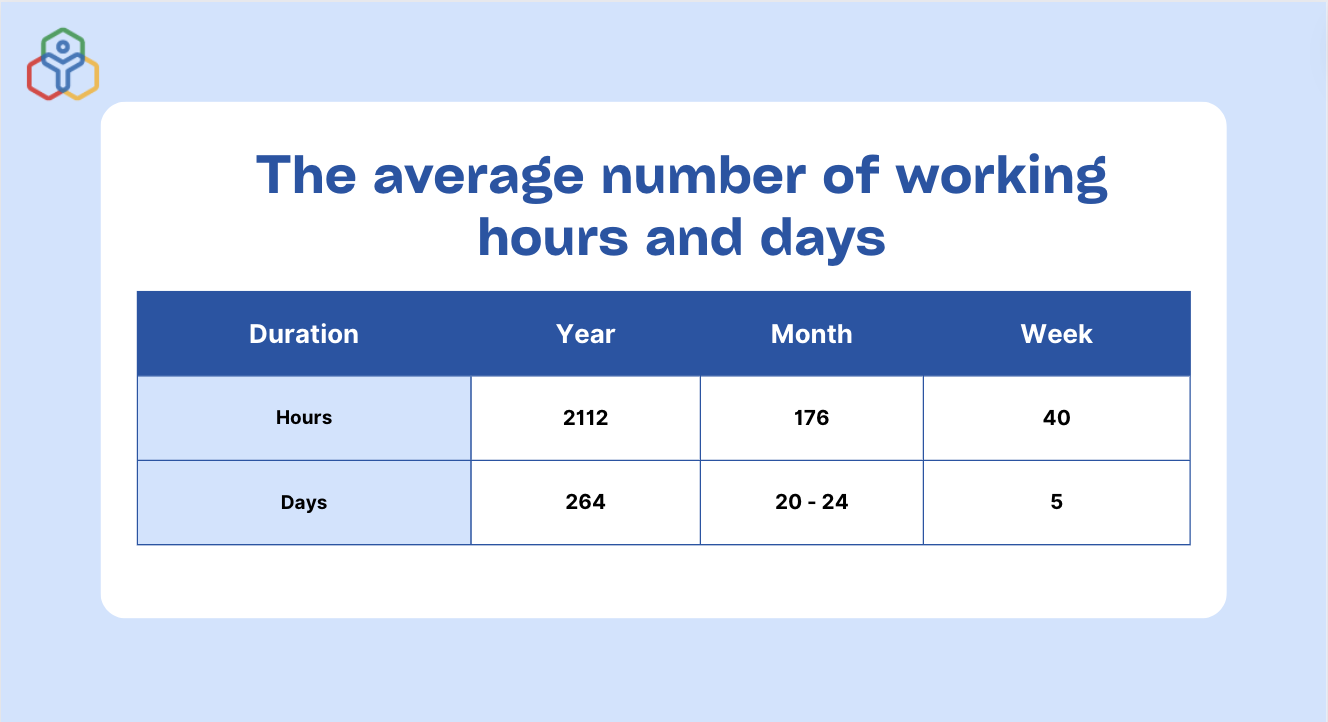- HOME
- HR insights
- How many hours do employees work in a year?
How many hours do employees work in a year?
- Last Updated : March 17, 2025
- 3.5K Views
- 5 Min Read

Knowing how many hours your employees work in a year is crucial for a few key reasons. A higher-than-average hour count may indicate that your employees are burnt out, or at the very least lacking a proper work-life balance. Laws and regulations mandate maximum work hours, so it's important to be sure that your organization complies with labor laws for your region. This data is also critical for accurate salary calculation and budget planning. Let's look at the standard workweek, how to calculate annual work hours based on this standard, and the alternative approaches for setting employee working hours.
Understanding the standard workweek
The definition of a standard workweek differs depending on an organization's culture, location, and industry. In many countries, employees work for a maximum of eight hours a day over five days, which amounts to 40 hours per workweek. The organization typically decides the workday's start and end time; in organizations with a more flexible culture, employees have the autonomy to decide their start and end time. The workdays themselves are also typically established by the organization.
Calculating annual working hours based on the standard workweek
The total number of working hours in a year is solely dependent on the number of hours your employees put in a week, but to give you a clear idea about how to calculate the annual working hours, here's a sample calculation based on the standard workweek:
Number of working hours in a week* Total number of weeks = Annual working hours
40 hours per week * 52 weeks in a year = 2,080 hours per year
On average, full-time employees adhering to the standard workweek work for an average of 2,080 hours in a year. Subtracting the total number of paid time off hours will give you the exact hours.
Now that we've understood the number of working hours in a year, let's break down the number of working hours and days in a year, month, and week:
Average number of working hours per day: On average, employees are expected to work 8hours a day.
Average number of working days in a week: Depending on their organizational policies, most companies work 4, 5, or 6 days a week.
Average number of working hours in a week: If your organization adopts the standard five-day workweek, employees will work for an average of 40 hours per week.
Average number of working days in a month: Based on the standard workweek, employees work for an average of 20 to 24 days a month.
Average number of working hours in a month: Say employees work for eight hours in a day; their average number of working hours for 22 days in a month would be 176 hours.
Average number of working days in a year: Considering that employees work for an average of 22 days a month, their average number of working days in a year would be 264 days.

Beyond the standard workweek
Many organizations have moved beyond the traditional 9 to 5 workweek. They are embracing more flexible workweeks that focus on productivity and output rather than the number of hours that employees put in. The following are some alternative workweek arrangements:
Shift-based week
Organizations providing round-the-clock customer service often implement a rotating shift schedule, dividing the workday into day, evening, and night shifts. Employees are typically required to adapt to these shifts based on the organization's operational needs. The weekly working hours may vary, extending beyond or falling short of the standard 40-hour workweek. The shift timings are usually set by the organization based on how many hours they are expected to be available for their customers.
Compressed workweek
In a compressed workweek, employees enjoy the flexibility to complete their 40-hour-per-week schedule in fewer than five days. For instance, they might work 10 hours per day across four days to meet their weekly hour requirements.
Four-day work week
This is a schedule where employees work four days a week for eight hours each day, leading to a total of 32 hours per week. Many organizations are considering this approach in order to maximize focus, efficiency, and productivity, as well as help employees have a better work-life balance.
Flexible working hours
In the flexible work hours arrangement, employees are able to determine their start and end time for the day. Organizations adopting flexible hours usually don't fixate on the number of hours their employees put in, instead focusing on productivity levels and output.
Understanding the legal aspect of working hours
The laws defining the total number of hours that employees can work differ based on location. Since these laws differ from region to region, it's good to know the national and regional regulations that apply to your organization before defining the number of working hours for your employees. Here's how different labor laws govern employee working hours in these three countries to give you a general idea:
Legal considerations in India
For instance, in India, the Industrial Employment Standing Orders Act of 1946 defines the maximum hours factory and workshop employees should be expected to work. Similarly, the Factories Act of 1948 dictates that no factory worker shall work more than 9 hours a day and 48 hours a week. It also states that employees who work for more than 9 hours should be entitled to receive overtime wages almost twice their usual rate. Further, the Shops and Establishments Act also lays down similar regulations for individuals employed in shops and other establishments.
Legal considerations in the USA
The Fair Labor Standards Act in the USA mandates overtime pay for employees working more than 40 hours a week. And, the Family and Medical Leave Act of the USA allows employees to take 12-week leave to care for their family members for 12 months. Some state-based labor laws dictate the resting hours that organizations should provide for the hours worked.
Legal considerations in the UAE
About the UAE region, Article 17 of the Federal Decree Law No 33 of 2021 on the Regulation of Labour Relations governs the working hours of employees. According to this particular law, employees working in the private sector can work for 8 hours a day. Breaks no less than one hour in a working day are mandated by the law too. However, the total number of working hours can increase or decrease based on the industry to which that particular organization belongs. Overtime hours, according to the law, should not increase to two hours per day.
Wrapping up
Understanding the number of hours your employees work in a year not only provides you with insights into your employee experience but also ensures you are in compliance with relevant labor laws. The standard workweek, often set at 40 hours per week, serves as a baseline for calculating annual working hours, but your organization's approach may differ depending on its needs.
 Tarika
TarikaContent Specialist at Zoho People


